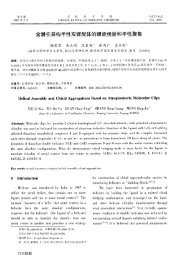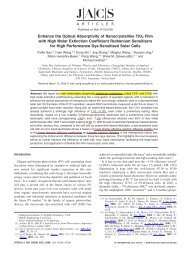Aerobic oxidation of alcohols over carbon nanotube-supported Ru ...
Aerobic oxidation of alcohols over carbon nanotube-supported Ru ...
Aerobic oxidation of alcohols over carbon nanotube-supported Ru ...
You also want an ePaper? Increase the reach of your titles
YUMPU automatically turns print PDFs into web optimized ePapers that Google loves.
134 X. Yang et al. / Applied Catalysis A: General 382 (2010) 131–137Table 1Effects <strong>of</strong> <strong>Ru</strong> species, catalyst support, and <strong>Ru</strong> loading on the activity <strong>of</strong> the <strong>supported</strong>ruthenium catalysts for the selective <strong>oxidation</strong> <strong>of</strong> benzyl alcohol. a,b .Entry Catalyst Substrate/<strong>Ru</strong> Conversion (%)1 6.0 wt% <strong>Ru</strong>Cl 3/CNTs 11 102 <strong>Ru</strong>O 2 17 153 6.0 wt% <strong>Ru</strong>/CNTs 17 984 6.0 wt% <strong>Ru</strong>/TiO 2 17 415 6.0 wt% <strong>Ru</strong>/AC 17 806 4.0 wt% <strong>Ru</strong>/CNTs 26 777 2.0 wt% <strong>Ru</strong>/CNTs 50 41a Reaction conditions: substrate (2 mmol), solvent (toluene: 10 mL, H 2O: 5 mL),85 ◦ C, p(O 2) = 0.1 MPa, 3 h.b Selectivity <strong>of</strong> benzaldehyde is 100%.<strong>supported</strong> one, indicating that CNT is a suitable support for alcohol<strong>oxidation</strong> reactions. As the <strong>Ru</strong> loading increases from 2 wt% to 6 wt%(entries 7, 6, and 4), the conversion <strong>of</strong> benzyl alcohol increases correspondingly,while the benzaldehyde selectivity remains at 100%,which is rationalized by the fact that even at higher catalyst loading,small clusters are still dominant.The effect <strong>of</strong> solvents on the activity <strong>of</strong> <strong>Ru</strong>/CNTs catalysts isshown in Table 2. Under identical reaction conditions, the catalyticactivity <strong>of</strong> <strong>Ru</strong>/CNTs in water is much higher than in typical polarand non-polar organic solvents such as ethanol and toluene. Whenwater is used as solvent, the main product is benzoic acid, implyingthat water promotes carboxylic acid formation. With tolueneas solvent, a higher conversion is achieved in comparison to thatobtained with the ethanol solvent, and at the same time, a muchhigher selectivity to benzaldehyde is also obtained. With ethanolas solvent, the main product is ethyl benzoate. It is known thatthe solubility <strong>of</strong> O 2 in the organic solvents is much higher than inwater. Obviously, the concentration <strong>of</strong> O 2 dissolved in a solvent isnot the g<strong>over</strong>ning factor for the remarkable changes in the <strong>oxidation</strong><strong>of</strong> benzyl alcohol in water. In fact, it is water, a weak base,which plays an important role during the reaction [31]. Water canfacilitate H abstraction from alcohol, thus promoting the reactivity.Table 3Effect <strong>of</strong> bi-solvents on the catalytic activity <strong>of</strong> <strong>Ru</strong>/CNTs for the selective <strong>oxidation</strong><strong>of</strong> benzyl alcohol. a .Toluene (mL) Water (mL) Conversion (%) Selectivity <strong>of</strong>benzaldehyde (%)10 1 67 10010 3 92 10010 5 98 10010 7 96 10010 10 67 100a Reaction conditions: benzyl alcohol (2 mmol), <strong>Ru</strong>/CNTs (<strong>Ru</strong>: 5.9 mol%), 85 ◦ C,p(O 2) = 0.1 MPa, 3 h.In addition, water can react with the aldehyde to form an aldehydehydrate, which further reacts with oxygen to form carboxylic acid.The effect <strong>of</strong> co-solvents on the catalytic activity <strong>of</strong> <strong>Ru</strong>/CNTscatalysts is shown in Table 3. With toluene as solvent, the conversion<strong>of</strong> benzyl alcohol is 50% and the selectivity to benzaldehyde is100%. When water is added, a substantial increase in the conversion<strong>of</strong> benzyl alcohol is obtained. When 5 mL <strong>of</strong> water and 10 mL <strong>of</strong>toluene are used as solvents, the highest conversion <strong>of</strong> benzyl alcohol<strong>of</strong> 98% is achieved, and the TOF is 178 h −1 after the first 0.5 h<strong>of</strong> reaction. Nevertheless, more water is not favored, which is evidencedby the fact that the conversion <strong>of</strong> benzyl alcohol decreaseswhen more water is added to the system.In the reaction system adopted here, four phases are involved:vapor, organic phase, aqueous phase, and solid catalyst. The aqueousphase and the organic phase are mixed homogeneously byvigorous agitation during the reaction. The aqueous phase isdispersed homogeneously in the organic phase in the form <strong>of</strong> emulsiondroplets under stirring. Optical microscopy showed that the<strong>Ru</strong>/CNTs catalysts assemble at the surface <strong>of</strong> the emulsion droplets(Fig. 5). It is known that lipophilic powder-like solids, such as <strong>carbon</strong>black and graphite powder, can be used as emulsifying agentsfor a W/O emulsion, where the size <strong>of</strong> the solid particulates ismuch smaller than that <strong>of</strong> the dispersed phase. Furthermore, theTable 2Effect <strong>of</strong> solvents on the catalytic activity <strong>of</strong> <strong>Ru</strong>/CNTs for the selective <strong>oxidation</strong> <strong>of</strong> benzyl alcohol. a .Solvent Conversion (%) Selectivity (%)Benzaldehyde Benzoic acid EsterEthanol 7 31 0 69Toluene 50 100 0 0Water 100 30 70 0a Reaction conditions: substrate (2 mmol), <strong>Ru</strong>/CNTs (<strong>Ru</strong>: 5.9 mol%), solvent (15 mL), 85 ◦ C, p(O 2) = 0.1 MPa, 3 h.Fig. 5. Optical micrographs <strong>of</strong> emulsion system a) during the process <strong>of</strong> reaction and b) after reaction formed with 0.2 g <strong>of</strong> <strong>Ru</strong>/CNTs catalyst, 2 mmol <strong>of</strong> benzyl alcohol, 10 mL<strong>of</strong> toluene, and 5 mL <strong>of</strong> water. In order to clearly identify the interphases <strong>of</strong> the water phase and oil phase, we marked water and oil with methylene blue and methyl orange,respectively. (For interpretation <strong>of</strong> the references to color in this figure legend, the reader is referred to the web version <strong>of</strong> the article.)
















